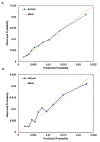A new model to predict ischemic stroke in patients with atrial fibrillation using warfarin or direct oral anticoagulants
- PMID: 30550837
- PMCID: PMC6545238
- DOI: 10.1016/j.hrthm.2018.12.005
A new model to predict ischemic stroke in patients with atrial fibrillation using warfarin or direct oral anticoagulants
Abstract
Background: Stroke risk stratification scores (eg, CHA2DS2-VASc) are used to tailor therapeutic recommendations for patients with atrial fibrillation (AF) in different risk groups.
Objective: The purpose of this study was to develop a tool to estimate stroke risk in patients receiving oral anticoagulants (OACs) and to identify patients who remain at high risk for stroke despite anticoagulation therapy.
Methods: Patients with nonvalvular AF initiating OACs were identified in the MarketScan data from 2007 to 2015. Using bootstrapping methods and backward selection of 44 candidate variables, we developed a model that selected variables predicting stroke. The final model was validated in patients with nonvalvular AF in the Optum database in the period 2009-2015. In both databases, the discrimination of existing stroke scores were individually evaluated and compared with our new model termed the AntiCoagulaTion-specific Stroke (ACTS) score.
Results: Among 135,523 patients with AF initiating OACs in the MarketScan dataset, 2028 experienced an ischemic stroke after anticoagulant initiation. The stepwise model identified 11 variables (including type of OAC) associated with ischemic stroke. The discrimination (C statistic) of the model was adequate (0.68; 95% confidence interval [CI] 0.66-0.70), showing excellent calibration (χ2 = 6.1; P = .73). ACTS was then applied to 84,549 AF patients in the Optum dataset (1408 stroke events) and showed similar discrimination (C statistic 0.67; 95% CI 65-0.69). However, previously developed predictive models had similar discriminative ability (CHA2DS2-VASc 0.67; 95% CI 0.65-0.68).
Conclusion: A novel model to identify AF patients at higher risk of ischemic stroke, using extensive administrative health care data including type of anticoagulant, did not perform better than established simpler models.
Keywords: Anticoagulation; Atrial fibrillation; Epidemiology; Ischemic stroke; Risk model.
Copyright © 2018 Heart Rhythm Society. Published by Elsevier Inc. All rights reserved.
Conflict of interest statement
Conflicts of Interest:
Dr. Lindsay Bengtson is an employee of Optum. All other authors have no potential conflicts of interest.
Figures
Comment in
-
Refining the prediction of stroke in atrial fibrillation: An elusive endeavor.Heart Rhythm. 2019 Jun;16(6):827-828. doi: 10.1016/j.hrthm.2018.12.012. Epub 2018 Dec 18. Heart Rhythm. 2019. PMID: 30576878 No abstract available.
References
-
- Poli D, Antonucci E, Grifoni E, Abbate R, Gensini GF, Prisco D. Stroke risk in atrial fibrillation patients on warfarin. Predictive ability of risk stratification schemes for primary and secondary prevention. Thromb Haemost 2009;101:367–372. - PubMed
-
- Gage BF, Waterman AD, Shannon W, Boechler M, Rich MW, Radford MJ. Validation of clinical classification schemes for predicting stroke: results from the National Registry of Atrial Fibrillation. JAMA 2001;285:2864–2870. - PubMed
-
- Lip GY, Nieuwlaat R, Pisters R, Lane DA, Crijns HJ. Refining clinical risk stratification for predicting stroke and thromboembolism in atrial fibrillation using a novel risk factor-based approach: the euro heart survey on atrial fibrillation. Chest 2010;137:263–272. - PubMed
-
- January CT, Wann LS, Alpert JS, et al. 2014 AHA/ACC/HRS Guideline for the Management of Patients With Atrial Fibrillation: Executive Summary. J Am Coll Cardiol 2014;64:2246–2280. - PubMed
Publication types
MeSH terms
Substances
Grants and funding
LinkOut - more resources
Full Text Sources
Medical


